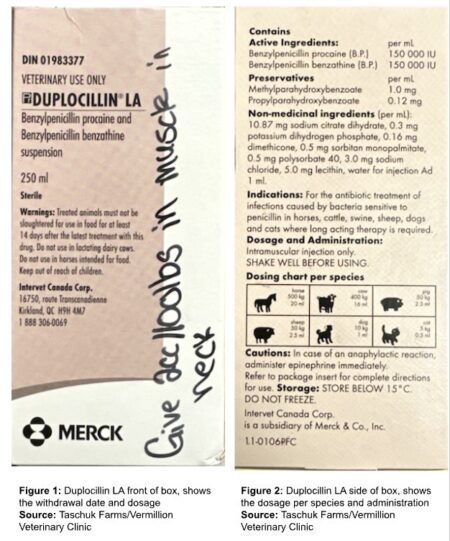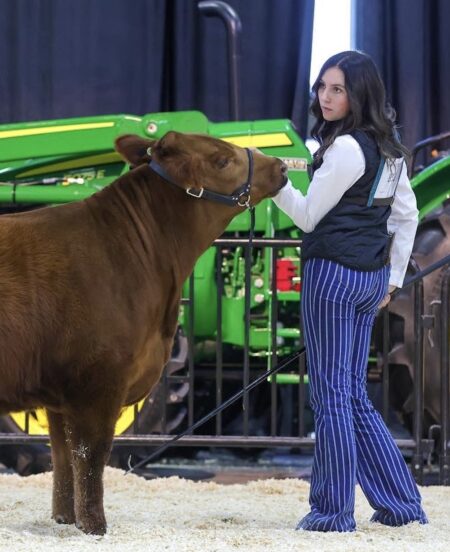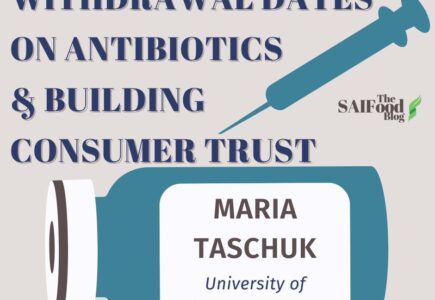By Maria Taschuk
University of Saskatchewan student
What are antibiotics? And why are they given to cattle?
The production of animals for food has increased greatly over the past many years; this means that the operations require a better disease management system. Antibiotics are used to treat and prevent infections that are caused by bad bacteria introduced to the animal. These infections can be very harmful to the animals, from pain to potential death. Cattle, like humans, can get sicknesses such as pneumonia, which can be very painful and, if left untreated, can become fatal. With this, antibiotics are essential in animal welfare to ensure the cattle can live as comfortably as possible. Not only are antibiotics used for treating the infection itself, but some antibiotics are used to lower inflammation and reduce the pain an animal feels from the infection.
Why do antibiotics have a negative connotation?
The media’s quick spread of false narratives has caused a negative view of antibiotics to widely spread throughout the consumer community. This is because some companies, such as A&W, use the negative connotation to their advantage to increase their sales. For example, the slogan, “serving beef raised without artificial hormones and steroids,” makes people believe that beef raised with hormones or steroids is harmful to them. In contrast, this is not the case.
The main concern consumers have found with livestock antibiotics is the promotion of drug-resistant bacteria, which develop when the microbial composition changes. When this occurs, it makes it so that the microbes are not affected by the antimicrobials, which are designed to kill them. In the studies done over the years, it has been concluded that the resistance levels are still low and that they have not increased over time. From the Beef Cattle Research Council article, we can also conclude that if the cattle industry were to completely eliminate antibiotic use, it would have a very negative effect on the cattle industry and, overall, would not have a benefit on human health. An example of this is producers use antibiotics to stop the spread of diseases, and if they chose not to treat a sick animal, they would potentially be dealing with a herd outbreak rather than treating the first one or two animals to get sick. This is especially seen with ringworm which starts as a small dry spot on the cattle that gets very itchy but it spreads like a wildfire on their own body but to other animals in the pen as well. By treating the animal when they first get ringworm it helps the producer to take a preventative measure to help stop the spread to other animals.
Withdrawal Dates to ensure the safety of human consumption of beef
Each antibiotic is given a withdrawal date; this is the amount of time the producer has to wait before the animal can be sent to auction or butchered. An example of this would be a 35-day withdrawal date on an antibiotic, which means that the animal treated cannot be shipped or butchered for those 35 days. The withdrawal time allows the drug to be reduced to safe levels in the animal’s body before being produced for human consumption. The withdrawal date is a safety regulation designed to ensure the safety of beef for human consumption and is calculated by using the data on the metabolism of the drug. After slaughtered with the drug in their body, the meat is tested, and the amount of residue is calculated. By doing this, the drug company can find how many days it takes for the residue to be below the safe ingestion limit.
 When administering antibiotics, each label has a specific amount that can be administered for the species. This amount has been found safe and effective for each animal, and what will be safely reduced to a safe residue level for human consumption. Figures 1 and 2 come from the Duplocillan box we have on Taschuk Farms in Alberta. This is my family farm, and we work closely with our two closest veterinary clinics, St. Paul Veterinary Clinic and Vermillion Veterinary Clinic, to ensure the welfare of our animals.
When administering antibiotics, each label has a specific amount that can be administered for the species. This amount has been found safe and effective for each animal, and what will be safely reduced to a safe residue level for human consumption. Figures 1 and 2 come from the Duplocillan box we have on Taschuk Farms in Alberta. This is my family farm, and we work closely with our two closest veterinary clinics, St. Paul Veterinary Clinic and Vermillion Veterinary Clinic, to ensure the welfare of our animals.
Duplocillan LA is a widely used antibiotic due to its stable action, low dose, and short withdrawal period. On the front of the box, it ensures the producer knows the withdrawal date is 14 days and that the animal must not be slaughtered for the use of food for at least 14 days. When we buy any antibiotics from our veterinarian, they also write the dosage and how to administer the antibiotic. This ensures we, as producers, are properly considering the safety of our livestock. On the next side of the box, it shows more dosages for other species when a producer needs to use that product on another species.
Growing consumer trust in antibiotics
Verified Beef Production + (VBP+) is a program that cattle producers can take to certify their operation follows the standards held for livestock operations. The standards followed include “food safety, animal care and environmental stewardship.”

VBP+ will also follow up and audit their verified operations to ensure they follow the animal, producer, and consumer safety standards. Both producers and consumers firmly trust this program, and it has been proven to provide education.
Conclusion
Antibiotics are widely used throughout the agriculture industry to ensure the health of the animals are at top priority. Producers use antibiotics to ensure herd health by stopping the spread of diseases when they first start to happen. With the use of antibiotics, all come with a withdrawal date which tells the producer how long they have to wait after the use of the antibiotic to either sell or butcher the animal. These withdrawal dates ensure the health and safety of human consumption of the meat. Meaning, that the meat that is bought in the grocery stores have all followed the correct protocol with withdrawal dates that ensures the antibiotics are well below the safe ingestion limit. This is determined through a test which tests the level of residue left in the meat before it is put on the shelves and sold. On the antibiotic bottle there are also specific dosages that can be calculated for different weights but also regarding specific species. This is important because the dosages are different regarding what species they are given to. Producers also work closely with their veterinarians and many antibiotics have to be bought right through the veterinarian clinic to ensure the correct antibiotic is used where it is needed. Overall, antibiotics are an important addition to the health and safety of each cattle herd by limiting the spread to other animals and helping the cattle to feel their best if they get sick.
Who am I?
 My name is Maria Taschuk, and I am from a small town in Alberta. We mix farm which is both grain and cattle. We run an operation of 1800 acres of grain and 130 head of Red and Black Angus as well as commercial cattle. I grew up through 4-H, and in 2015, I started showing cattle across Alberta. I have a large amount of knowledge in the agriculture industry both in the grain and livestock side of it. I am currently enrolled in the Bachelor of Agribusiness at the University of Saskatchewan in Saskatoon, where I have plans to go back to our farm and put my studies to work in Alberta to further our operation.
My name is Maria Taschuk, and I am from a small town in Alberta. We mix farm which is both grain and cattle. We run an operation of 1800 acres of grain and 130 head of Red and Black Angus as well as commercial cattle. I grew up through 4-H, and in 2015, I started showing cattle across Alberta. I have a large amount of knowledge in the agriculture industry both in the grain and livestock side of it. I am currently enrolled in the Bachelor of Agribusiness at the University of Saskatchewan in Saskatoon, where I have plans to go back to our farm and put my studies to work in Alberta to further our operation.


